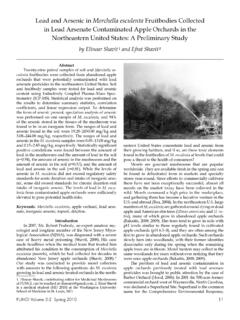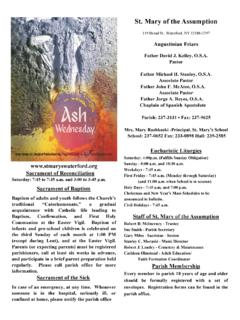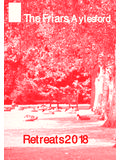Transcription of Early Morels and Little Friars, - FUNGI Magazine
1 AbstractThe spring ascomycete Verpa bohemica the Early morel has a long tradition of consumption in Emilia-Romagna (Northern Italy), where it is regularly collected, safely eaten and officially traded, as well as true Morels (Morchella spp.). Unfortunately, V. bohemica is still listed among suspect or toxic mushrooms in most of North American and extra-European texts, despite the lack of analytical confirmation for the occurrence of toxins such as gyromitrin and coprine, which V. bohemica has been allegedly blamed for in the past, and in the absence of sound toxicological evidence as well. In fact, poisonings occasionally reported in the old literature after consumption of V. bohemica might have well been misunderstood with the so-called neurological syndrome associated with ingestion of Morchella spp. which has been formally described only in recent years. Mushroom collectors should therefore be reassured that V. bohemica and true Morels share the very same edibility ascomicete primaverile Verpa bohemica ha una lunga tradizione di utilizzo a scopo alimentare in Emilia-Romagna, dove viene regolarmente raccolto, consumato e commercializzato, alla stregua delle spugnole propriamente dette (Morchella spp.)
2 Purtroppo V. bohemica continua ad essere elencata tra le specie sospette o tossiche nella maggior parte dei testi nordamericani ed extraeuropei, nonostante la mancanza di conferme analitiche della presunta presenza di tossine quali la giromitrina e la coprina per cui V. bohemica stata accusata in passato, e anche in assenza di chiari indizi tossicologici. Infatti, i casi di intossicazione riportati in passato in letteratura a seguito del consumo di V. bohemica devono essere piuttosto ricondotti ad un errata interpretazione della cosiddetta sindrome neurologica associata al consumo di funghi del genere Morchella che stata correttamente caratterizzata solo in anni recenti. pertanto necessario rassicurare i raccoglitori circa lo status di commestibilit di V. bohemica, che da considerare assolutamente identico a quello delle vere 1. Verpa bohemica from Northern Upper Appennines (Farn near Lizzano in Belvedere (BO), Italy).Photo by Nicola FUNGI Volume 8:1 Spring 2015 Early Morels and Little friars , or a Short Essay on the Edibility of Verpa bohemicaPaolo Davoli a,* and Nicola Sitta ba via Pellegrini 2/18, 41058 Vignola (MO), Italy; e-mail: Loc.
3 Farn 32, 40042 Lizzano in Belvedere (BO), Italy; e-mail: 1. Verpa bohemica from Northern Upper Appennines (Farn near Lizzano in Belvedere (BO), Italy).Photo by Nicola have featured an iconic role in Italian food tradition since time immemorial. There is plenty of historical evidence documenting the usage of mushrooms for food purposes by ancient Romans, who were particularly fond of boleti (Amanita caesarea) but did collect and also trade suilli, boletes (Boletus edulis and allied species) (Buller, 1914; Jaeger, 2011). Such a tradition of consumption has survived and further developed along the centuries in Italy, and the range of mushroom species that are used for food has meanwhile broadened. In fact, despite the fact that boletes (porcini in Italian) today represent the mushrooms par excellence in Italy and still account for most of the market share in mushroom trade (Sitta and Floriani, 2008), many edible fungal species other than porcini are widely collected and traded nationwide or on regional is the case of true Morels (Morchella spp.)
4 , which are most prized and actively sought after in the whole of Italy under the trivial name spugnole (= Little sponges). Morel hunting and consumption in Italy does not reach the popularity as in the US or in France Italian mushroom hunters and gourmands have a passion for porcini above all! Nonetheless it is tempting to speculate that the springtime appearance of potentially tasty food items such as Morels , which could be used as accompaniments to otherwise plain cereal-based staple foods, must have represented a major drive for collection in ancient times. In this respect, however, it is not clear when consumption of Morels first appeared in Italy. Some claimed that Pliny the Elder might have made an explicit reference to them in his Naturalis Historia (Maggiulli, 1977), but such a speculation is somewhat questionable in our opinion. On the contrary, it is most likely that the first ever documentary evidence clearly describing the usage of Morels for food purposes in Italy can be traced back to the Late Middle addition to true Morels , in Emilia-Romagna (Northern Italy) also Verpa bohemica (Krombh.)
5 J. Schr t. (Figs. 1 3) has a long tradition of consumption and it is even traded officially on a local scale (Figs. 4 5). In the province of Modena V. bohemica fruits from March to Early May, sometimes abundantly, whereas true Morels appear two or three weeks later, under conditions of same elevation and slope orientation; V. bohemica grows under several species of broadleaved trees, in particular elms (Ulmus spp.), poplars (Populus spp.) and willows (Salix spp.), often along rivers and streams, and often hidden in dense thickets of bramble and wild roses (Rubus spp. and Rosa spp., respectively) in the understory. In moisture-rich locations it can also grow abundantly in degraded chestnut or beech woods, especially at the edge, or close to ruins of buildings and stone walls. Its distribution range spans from the foothills of Lower Appennines (and adjacent areas bordering the river Po plain) to the Upper Appennines, up to elevations of ca. 1500 m above sea as the Early morel in English-Figure 2.
6 Verpa bohemica from Northern Lower Appennines (Vignola (MO), Italy). Photo by Paolo Volume 8:1 Spring 2015 Figure 3. Verpa bohemica from Northern Lower Appennines (Vignola (MO), Italy). Photo by Paolo countries, in the province of Modena V. bohemica is usually referred to as frat in in the local dialect (in Italian it translates as fratino, Little friar), whilst true Morels are collectively called sfurac li instead (Bellei, 1999); sometimes the name fr (in Italian frate = friar) is also used for V. bohemica. By close analogy, the trivial names frat in/fr are often applied locally also to Mitrophora semilibera (DC.) L v. (syn. Morchella semilibera DC.). (Bellei and Benatti Spennato, 1994). It is worthy to note at least from an ethnomycological viewpoint that Helvella crispa (Scop.) Fr. is called in the local dialect sur ina and prit in (corresponding to Italian suorina and pretino) (San Donnini, 1899), Little nun and Little priest, the US Verpa bohemica is usually regarded as suspect or toxic by many field guides; even when it is reported as edible, it is generally not recommended for eating and caution is always given that it may cause gastrointestinal discomfort in some people.
7 According to Beug et al. (2014), V. bohemica is edible for some but poisonous to many others, causing variable reactions, including severe gastrointestinal upset and temporary loss of coordination. Similar information about the toxicity of Early Morels can be found on mushroom books aimed at a worldwide audience ( Hall et al., 2003; Roberts and Evans, 2011) and also in some (albeit few!) Italian and European field guides, even though most of them always list V. bohemica as edible, and rightly so. In the FAO s compendium of wild edible mushrooms, V. bohemica is included in the global list of wild FUNGI used as food, and it is also listed between the economically important wild FUNGI (Boa, 2004). Also to the best of our knowledge V. bohemica can be safely eaten and it should therefore be included among edible fungal species. Accordingly, in Emilia-Romagna it is officially included at a regional level in the positive list of edible mushrooms allowed for trade (Italy, 1995; Emilia-Romagna, 1997).
8 Clearly, it is one of those cases of contrasting evaluation of edibility that are often found in the (ethno)mycological literature (see Sitta and Davoli, 2012).At least as far as the North American mycological literature is concerned, we believe that such a confusion about the edibility of V. bohemica stems from Lincoff and Mitchel s Toxic and Hallucinogenic Mushroom Poisoning (1977), an authoritative source of mycotoxicological information that still represents a leading reference in the field and which has been frequently quoted by mycologists in subsequent decades. In fact, Lincoff and Mitchel, quoting earlier and scattered cases of poisonings caused by ingestion of Early Morels , wrote: ..it is possible that Verpa bohemica, or certain strains or fruiting of it, contain or can synthesize low levels of gyromitrin. (Lincoff and Mitchel, 1977). To the best of our knowledge, however, the presence of gyromitrin in V. bohemica has never been demonstrated experimentally. Despite thorough bibliographical searches, we could not find a single reference that confirms unambiguously the detection of gyromitrin and analogues thereof in V.
9 Bohemica, neither before nor after the publication of Lincoff and Mitchel s book. Nonetheless their view has certainly consolidated over the years and must have remained widely accepted in the US and elsewhere. We wonder about the official status of V. bohemica in the US. For instance, is it allowed for 6 FUNGI Volume 8:1 Spring 2015 Figure 5. Close-up of a basketful of Verpa bohemica ready to be offered for sale. Photo by Paolo As far as we know, according to the FDA, V. bohemica is lumped with Gyromitra spp. and Helvella spp., and all of them are considered toxic (FDA, 1984; Gecan and Cichowicz, 1993). We have found official reports from the FDA whereby detection of V. bohemica in consignments of dried and canned Morels for US import resulted in non-compliance of the shipment and failure to obtain custom clearance (see for example FDA Import Alert 25-02, 2011). Caution is certainly required when dealing with Gyromitra, but officially listing Verpa bohemica as toxic in the absence of any sound experimental evidence looks a bit too it is acknowledged that almost all edible wild mushroom species can cause poisonings with gastrointestinal symptoms for reasons such as incomplete cooking, ingestion of old specimens or over-indulgence in consumption itself.
10 Although this may have well occurred also with V. bohemica, we surmise that the gastrointestinal and neurological symptoms reported after eating Early Morels might have always been misunderstood with the so-called cerebellar syndrome associated with the consumption of conspicuous quantities of Morchella spp., which has been clearly documented only in recent years (Pfab et al., 2008; Berndt, 2010; Saviuc et al., 2010). In fact, the presence of neurological symptoms in the cerebellar syndrome match perfectly with the descriptions of poisonings by V. bohemica reported in earlier literature, whereby uncoordination or lack of muscular coordination was alleged occurrence of coprine in V. bohemica has been also invoked to explain poisonings that were reported after consumption of Early Morels in conjunction with alcoholic beverages. Despite the absence of any experimental confirmation from an analytical viewpoint, we find it most surprising that such a speculation has crept up in the (myco)toxicological literature, so that V.









